

| Hattie
Mae | Wednesday, June 24, 2009 I started right in on the coupling again, continuing the process from yesterday. After a short while, I sensed that the coupling was moving a bit easier, and I found that I was able to tap it off the remaining distance with a hammer, which saved a lot of time and effort. I removed the shaft, coupling, and stuffing box assembly to the bench for inspection. |
|
The shaft was badly scored where it had run through the Cutless bearing and packing nut; scoring is common on old, neglected shafts. I cleaned off the external corrosion and debris with some sandpaper, only to reveal pink areas of deteriorated bronze in several areas, most of which had been hidden while the shaft was still in the boat (i.e. within the stern tube/stuffing box area). With the combination of deep scoring (which would limit future ability to seal well at the packing) and probable metal weakness, it looked like the shaft would have to be replaced. I set it aside for later determination. |
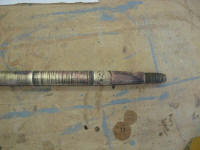
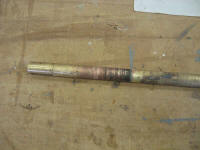 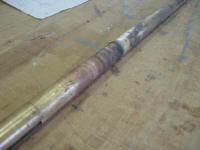
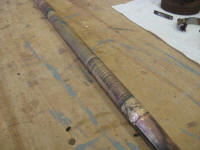 |
|
Of course the old flax packing from the stuffing box was in poor condition, but otherwise the bronze housing and nuts were in fine shape and could be re-used later. The hose, of course, was known to be past its useful life. |
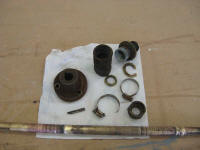 |
|
I started looking at the Cutless bearing with an eye towards removal and replacement, but discovered that removal would be quite a process. Someone had installed the bearing so its end was flush with the end of the stern tube, leaving nothing to grab to aid in removal. Additionally, if there were any setscrews holding the bearing in place, as typical, they were heavily glassed over: someone had done a very nice job strengthening the external part of the stern tube and tying it in with the aperture, but in doing so they also eliminated any possibility of removing, or even locating, the bearing set screws. It also appeared that the bearing was epoxied (or otherwise adhered) in place within the tube. With limited time remaining on this project, I decided it was best to reconnoiter and determine the best way forward, and therefore postponed any ideas of removing the bearing for the moment so I could focus on the other tasks I needed to complete within the original project scope. |
 |
|
I turned to the fuel tank installation once more. It occurred to me that another Triton I had in the yard, and which was awaiting her turn in the shop, had a newer-looking fuel tank in the locker, and I realized belatedly that it was highly likely that it was the same tank as the model I had selected for Hattie Mae. I went out to take a look, and sure enough, it was an RDS 59043. This was good news, as it confirmed the fit of the tank, and gave me a real-time visual idea of how the tank would fit in the locker. |
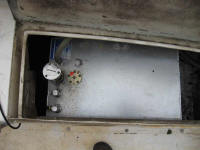 |
|
With this new information, I forged ahead. Using some rough marks I'd made off the cardboard mockup on the hull as a guide, I drew in level lines demarking the edge of a platform against the hull, and against the inside of the cockpit locker. From these marks, I created a template of the plywood platform, using cardboard. Once I had the platform template, I made rough measurements of the height beneath the platform to the hull, and then made templates for fore and aft supports, or small bulkheads, which would form the basis of the tank platform's support. |
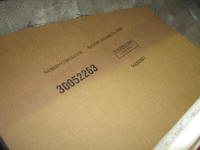 |
|
Once I had the templates fine-tuned, I transferred all the shapes to a sheet of Meranti plywood and cut them out as needed. I added mahogany cleats and longitudinal cross members at the top edges, temporarily screwed all the pieces together, and set the frame in place to check the fit, with and without the plywood platform. Then, I checked once more the fit of the tank mockup to be sure the height of the new platform allowed the mockup to slide in unimpeded. |
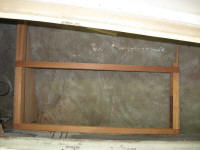
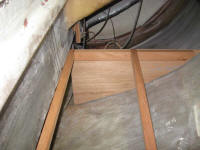
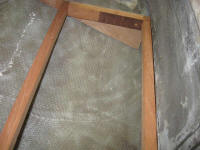 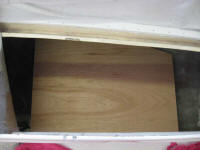
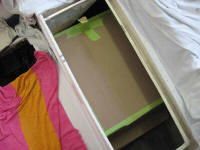 |
|
I removed the various pieces and disassembled the supporting framework so that I could epoxy the frame pieces to add strength to the screws that I'd already installed. Then, I epoxy-coated the plywood, including the bottom side of the platform, which would be inaccessible once installed. I left the top of the platform raw for the moment for later coating. |
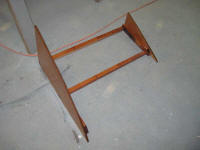
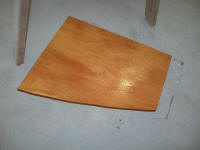 |
|
After allowing the epoxy to cure for a while, I installed the framework in the boat, using a bed of thick epoxy to glue and fillet the frame bulkheads in place. Once the fillets had partially cured, I installed two layers of 6" biaxial tabbing on both sides of the two bulkheads, and epoxy-coated all the remaining wooden pieces. |
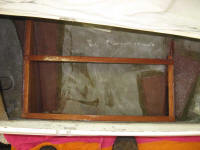 |
|
While waiting for the epoxy to cure, I moved on to the cockpit hatch installation. I had to open up the deck cutout a bit at the corners, since I'd guessed at the radius when I made the original cuts, but after just a little work the framework slipped into place. I removed a bit of the flange where it interfered with the cockpit-mounted shift assembly, which I'd anticipated. Next, I masked around the hatch flange to protect the deck, and drilled pilot holes at each screw location. T hen, I overbored these holes and filled the larger openings with thickened epoxy, leaving it to cure overnight before I approached the final installation of the hatch. |
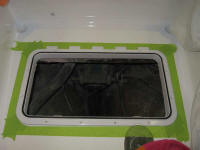
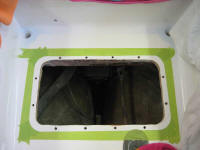
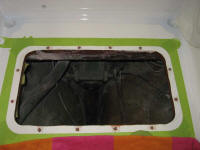 |
|
I also managed two coats of varnish on the new forward hatch frame--one very early in the day, and a second at the end of the day, which I applied after lightly sanding the first. |
 |
|